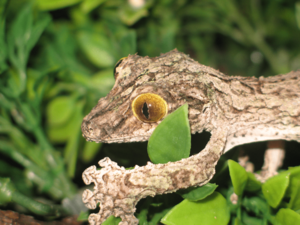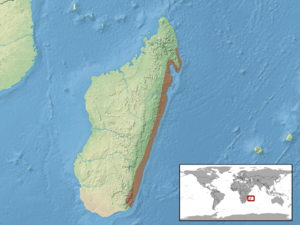Uroplatus sameiti facts for kids
Quick facts for kids Uroplatus sameiti |
|
|---|---|
 |
|
| Conservation status | |
| Scientific classification | |
| Genus: |
Uroplatus
|
| Species: |
sameiti
|
 |
|
| Geographic range of U. sameiti in Madagascar | |
The Uroplatus sameiti is a special kind of gecko known as a leaf-tailed gecko. These amazing creatures are found only in Madagascar. They live in both old, untouched forests and newer, regrowing forests on the island. One of their coolest tricks is changing their skin color to blend in perfectly with their surroundings. They also have special skin flaps that help hide their shape when they are resting.
Because their homes are disappearing and too many are being taken for pets, these geckos are protected animals.
Contents
Meet the Leaf-Tailed Gecko
The name Uroplatus comes from two old Greek words. "Oura" means "tail" and "platys" means "flat." This describes their unique flat tails! The second part of their name, sameiti, honors a person named Joachim Sameit.
There are 14 different kinds of Uroplatus geckos, and all of them live only in Madagascar. The Uroplatus sameiti is very similar to another gecko, the Uroplatus sikorae. It can be quite tricky to tell them apart! Scientists are still studying them to find clear ways to tell the two species apart.
What Does It Look Like?
Uroplatus sameiti geckos are active at night, which means they are nocturnal. They also live in trees, making them arboreal. Their eyes are very big and don't have eyelids. They have bright yellow parts around their pupils, which are shaped like slits. These eyes are perfect for seeing in the dark!
These geckos can grow to be about 6 to 8 inches (15 to 20 cm) long, not counting their tail. During the day, they usually hang upside down on tree trunks, resting. When night comes, they leave their resting spots to look for food.
Just like all leaf-tailed geckos, their tails are flat. Their skin colors are amazing camouflage. They can be grayish-brown, black, or greenish-brown. They have patterns that look just like tree bark, or even the moss and lichens growing on it. The Uroplatus sameiti has special skin flaps along its body, head, and legs. These are called "dermal flaps." When the gecko presses them against a tree, they break up its outline. This makes the gecko almost impossible to see! They can also change their skin color a little bit to match their surroundings even better.
What Do They Eat?
Uroplatus sameiti geckos are insectivores. This means they mostly eat insects and other small creatures like spiders. They also enjoy eating land snails.
Where Do They Live?
The Uroplatus sameiti lives only in the wet, lowland forests along the eastern coast of Madagascar.
Life in Captivity
It's hard to know exactly how many of these geckos are kept as pets. This is because they look so much like Uroplatus sikorae. People who keep them often have them in pairs or groups of three. They eat many different kinds of insects that are the right size for them, like crickets and moths. They will also eat snails if they are offered. If they successfully have babies in captivity, the female gecko will lay eggs about every 30 days. The eggs then take about 90 days to hatch.
Threats to Their Survival
The biggest dangers to the Uroplatus sameiti's future are the destruction of their forest homes and people collecting them for the pet trade. Forests in Madagascar are being cut down, which means these geckos lose their habitat.
The World Wide Fund for Nature (WWF) has listed all Uroplatus species as "Top ten most wanted species." This means they are highly threatened by illegal wildlife trade. Too many of these geckos are being caught and sold around the world. Because of this, the Uroplatus sameiti is a protected animal.


